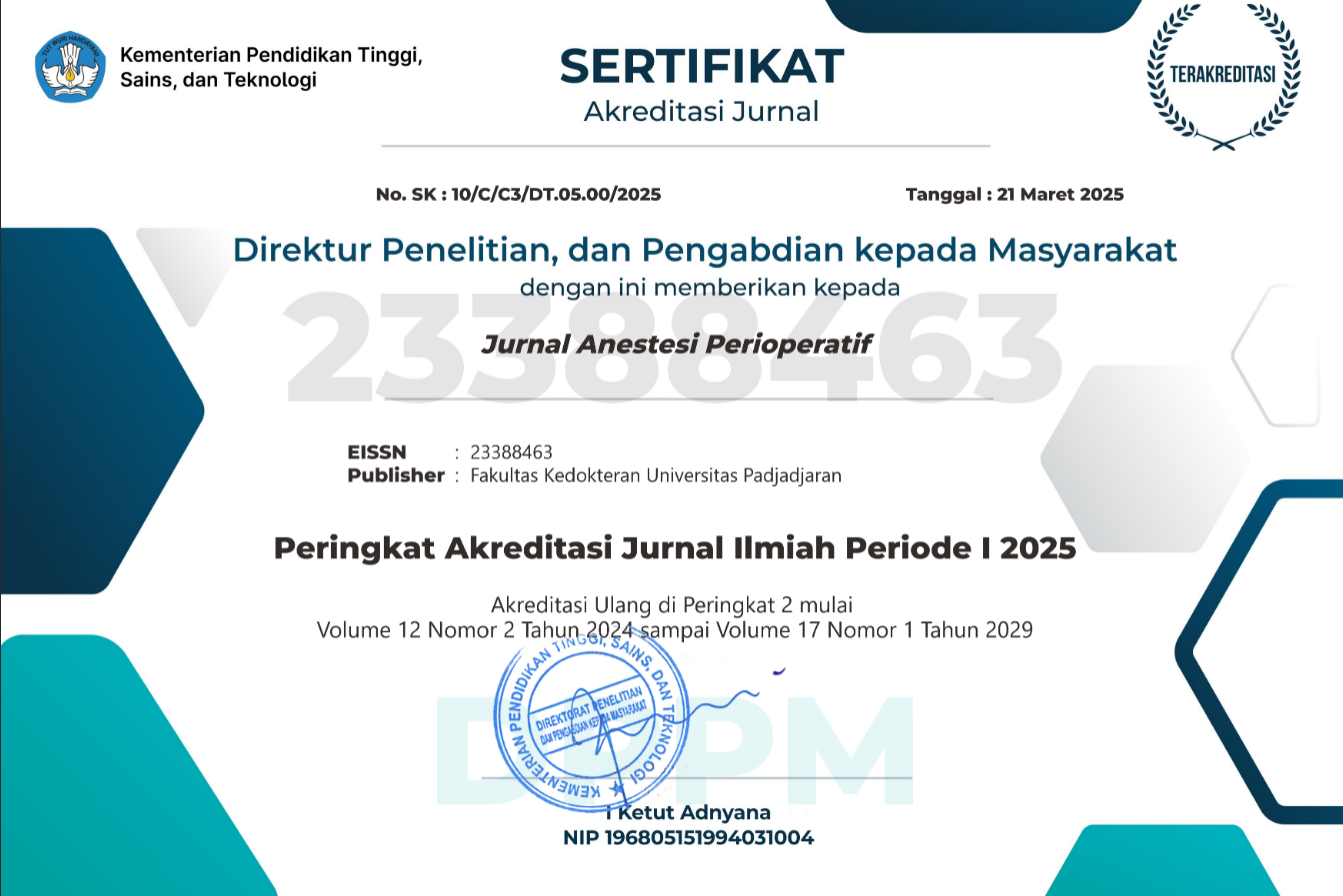Pengaruh Premedikasi Midazolam 0,04 mg/kgBB sebelum Anestesi Spinal terhadap Respons Tubuh Saat Insersi Jarum Spinal dan Kepuasan
Abstract
Conscious sedation pada pasien yang dilakukan tindakan anestesi spinal membuat pasien menjadi lebih nyaman, kooperatif selama penyuntikan, dan mengurangi respons tubuh saat insersi jarum spinal. Midazolam memiliki efek ansiolitik, sedatif-hipnotik, amnesia, melemaskan otot, dan mengurangi mual-muntah akibat pembedahan. Tujuan penelitian ini mengetahui pengaruh premedikasi midazolam 0,04 mg/kgBB yang diberikan 30 menit sebelum dilakukan anestesi spinal terhadap respons tubuh pasien saat insersi jarum spinal dan kepuasan pasien terhadap anestesi spinal. Penelitian dilakukan periode September–Desember 2019 di RSUP Dr. Hasan Sadikin Bandung. Penelitian bersifat prospektif eksperimental menggunakan uji klinis acak buta ganda terhadap 46 subjek yang dibagi acak ke dalam 2 kelompok, yaitu kelompok kontrol (kelompok K, n=23) dan kelompok premedikasi midazolam (kelompok M, n=23). Pasca- pemberian premedikasi midazolam dinilai respons tubuh pasien saat insersi jarum spinal menggunakan prick response score dan kepuasan pasien dengan numeric rating scale. Analisis statistik untuk respons penyuntikan dan kepuasan pasien diuji dengan uji chi-square. Hasil penelitian menunjukkan respons tubuh pasien saat insersi jarum spinal berkurang (p<0,01) dan kepuasan pasien meningkat (p<0,01) pada kelompok premedikasi midazolam. Simpulan, premedikasi midazolam 0,04 mg/kgBB yang diberikan 30 menit sebelum anestesi spinal menurunkan respons tubuh pasien saat insersi jarum spinal dan meningkatkan kepuasan pasien terhadap anestesi spinal
The Effect of Midazolam Premedication 0.04 mg/kgBW before Spinal Anesthesia to Body Response during Spinal Needle Insertion and Satisfaction
Conscious sedation leads to a more comfortable spinal intervention for patients, making them more cooperative as well as decreasing body response during spinal needle insertion. Midazolam has anxiolytic, hypnosis-sedative, amnesia, muscle relaxation effects and ability to reduce nausea and vomiting related to a surgery. The aim of this study was to determine the effect of 0,04 mg/kgBW midazolam premedication administered 30 minutes before spinal anesthesia on body response during spinal needle insertion and patient satisfaction. The prospective experimental study with a randomized, double blinded clinical trial approach was conducted from September to December 2019 in Dr. Hasan Sadikin General Hospital Bandung. Forty-six subjects were randomly divided into 2 groups: a control group (group K, n=23), and a midazolam premedication group (group M, n=23). After premedication with midazolam, the patient`s body response during spinal needle insertion were evaluated using the prick response score and their satisfaction was assessed using the numeric rating scale. Statistical analysis used to analyze body response during needle insertion and patient satisfaction was the Chi-Square test. Results howed that patient`s body response during spinal needle insertion were reduced (p<0.01) and patient satisfaction increased (p<0.01) in the midazolam premedication group. In conclusion, 0.04 mg/kgBW midazolam premedication administered 30 minutes before spinal anesthesia reduces patient body response during spinal needle insertion and increases patient satisfaction on spinal anesthesia.
Keywords
Full Text:
PDFReferences
Guerrero FJB, Camargo DG, Romero RP, Bustos WL, Clason ER. A Comparative analysis of 3 sedation guidelines for patients undergoing subarachnoid anesthesia. Randomized, single blind clinical trial. Rev Colomb Anestesiol. 2015;43(2):122–8.
Neeru B, Hardip S, Pal AJ, Lipsy B, Sukhman K. Comparison of midazolam versus clonazepam as premedication scheduled for elective abdominal hysterectomies. Int J Med Res Rev. 2016;4(8):1330–4.
Kumar VRH, Athiraman UK, Jahagirdar SM, Sripriya R, Parthasarathy S, Ravishankar M. Comparison of efficacy of three subanesthetic doses of ketamine in allaying procedural discomfort during establishment of subarachnoid block: a randomized double-blind trial. Saudi J Anaesth. 2015;9(1):55–9.
Zencirci B. Midazolam in spinal anaesthesia-intrathecal or intravenous?. Dalam: Whizar-Lugo VM, penyunting. Topics in spinal anaesthesia. Intech Open. 2014;2014:123–37.
White PF, Eng MR. Intravenous anesthesia. Dalam: Barash PG, Cullen BF, Stoelting RK, Cahalan MK, Stock MC, Ortega R, penyunting. Clinical anesthesia. Edisi ke-7. Philadelphia: Wolters Kluwer-Lippincott Williams & Wilkins; 2013. hlm. 905–12.
Mui WC, Chang CM, Cheng KF, Lee TY, Ng KO, Tsao KR, dkk. Development and validation of the questionnaire of satisfaction with perioperative anesthetic care for general and regional anesthesia in taiwanese patients. Anesthesiology. 2011;5(114):1064–75.
Boku A, Inoue M, Niwa H. Effective dosage of midazolam to erase the memory of vascular pain during propofol administration. Anesth Prog. 2016;63(3):147–55.
Anderson, B. Midazolam and how physiologic changes in the elderly patient`s body lead to adversed effects. 2018 [diunduh 11 Mei 2020]. Tersedia dari: https://www.digitalcommons.assumption.edu.
Jun J, Han J, Choi A, Kim YJ, Lee JW, Kim DY, dkk. Adversed events of conscious sedation using midazolam for gastrointestinal endoscopy. APM. 2019;14:401–6.
Idris M, Weldegiorgrs GG, Tesfamariam EH. Maternal satisfaction and its associated factors toward spinal anesthesia for caesarean section: a cross-sectional study in two Eritrean hospitals. Anesthesiol Res Pract [Online Journal] 2020 [diunduh 8 Mei 2020]. Tersedia dari: https://doi.org/10.1155/2020/5025309.
Maheshwari D, Ismail S. Preoperative anxiety in patients selecting either general or regional anesthesia for elective cesarean section. J Anaesthesiol Clin Pharmacol. 2015;31(2):196–200.
Mingir T, Ervatan Z, Turgut N. Spinal anesthesia and perioperative anxiety. Turk J Anaesth Reanim. 2014;42:190–5.
Kanto J. Preoperative anxiety. 2012 [diunduh 8 Mei 2020]. Tersedia dari: https://www.link.springer.com.
Mokhtar AM, Elsakka AI, Ali HM. Premedication with midazolam prior to cesarean delivery in preeclamptic parturients : a randomised controlled trial. Anesth Essays Res. 2016;10(3):631–6.
Woldegerima YB, Fitwi GL, Yimer HT, Hailekiros AG. Prevalence and factors associated with preoperative anxiety among elective surgical patients at university of Gondar hospital. Int J Surg. Open. 2018;10:21–9.
Sharif A, Naqvi SEH, Khan A. Conscious sedation in spinal anesthesia: a comparative study of propofol versus midazolam. KMUJ. 2017;9(1):15–8.
Matsuura N. Muscle power during intravenous sedation. JDSR. 2017;53:125–33.
Mowafi HA. Spectral entropy as an objective measure of sedation state in midazolam-premedicated patients. Saudi J Anaesth. 2012;6(2):131–5.
Eren G, Cukurova Z, Demir G, Hergunsel O, Kozanhan B, Emir NS. Comparison of dexmedetomidine and three different doses of midazolam in preoperative sedation. J Anaesth Clin Pharmacol. 2011;27(3):367–72.
Savant KB, Patel H, Patel V. Sedation during spinal anaesthesia: a comparison between dexmedetomidine and midazolam infusion. IJBAR. 2017;8(05):228–32
DOI: https://doi.org/10.15851/jap.v8n2.2035
Article Metrics
Abstract view : 1794 timesPDF - 1038 times
This Journal indexed by

JAP is licensed under a Creative Commons Attribution-NonCommercial 4.0 International License
View My Stats



